Any compression gear that goes over the ankle, including those that reach the knees, thighs, or waist, can help with ankle swelling.
High-quality compression socks will work better than cheap or one-size-fits-all brands.
Swollen ankles and feet are just the worst – they can be uncomfortable, unsightly, and downright painful at times.
But have no fear.
We – and compression socks – are here!
We cover the basics of choosing the best compression socks for ankle swelling and how to choose the right pair for you.
What causes swelling?
Let’s talk about why swelling occurs in the first place.
Symptoms and causes of swollen ankles and feet
Our body contains blood and other essential fluids that perform specific functions in the body. These fluids and how they circulate throughout the body are crucial for the regular operation of the body.
Heart contractions are responsible for pumping fresh blood into the blood vessels and for drawing de-oxygenated blood back towards itself.
If blood, for some reason, begins to pool in the feet and ankles, then it can cause swelling in the area and the symptoms can include:
- Puffiness in the tissue of the affected area
- Pitting or indentation on the affected area
- Shiny skin surface
- An increase in the size of the affected limb
- The feeling of heaviness, soreness, and even pain in the affected area
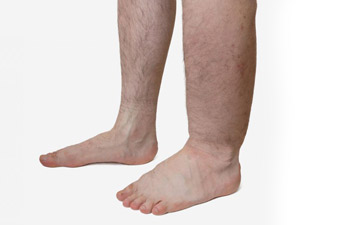
If left unattended for an extended period, and the patient does not take appropriate measures against it, your problem can progress further and possibly cause numbness and swelling of the entire lower body. The manifestation of such extreme symptoms can make movement very difficult.
Here are some of the causes, and how they can aggravate your situation:
- Edema
The most common cause of ankle and foot swelling is edema or dropsy. This is simply the pooling of blood in your lower limbs caused by the lack of movement and standing or sitting in one place. Edema can sometimes also affect thighs, legs, and upper limbs too.
When fluid retention is due to gravity, the phenomenon is known as dependent edema.
Lymphedema is the medical term for the swelling that is caused by leaky lymph vessels and the accumulation of lymph fluid.
If the skin becomes pitted or applying pressure leaves an indentation on the skin surface, then this type of edema is pitting edema.
- Trauma to the ankle or foot
Injury or trauma to the foot can also cause swelling, pain, and inflammation, such as in a leg or ankle sprain.
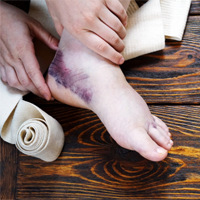
If the injury is severe, it can cause torn ligaments, tissue damage, and even bone fracture. All of these may also result in swelling as well, and requires a doctor’s visit.
- Pregnancy
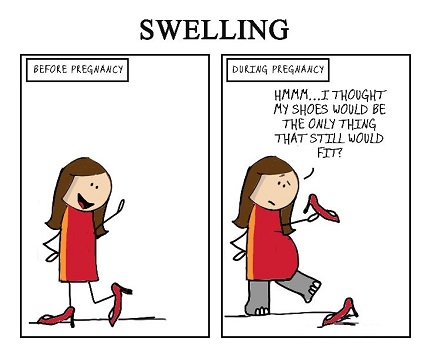
During the last trimesters of one’s pregnancy, the sudden increase in weight exerts extra pressure on the veins and may cause fluids to accumulate, and resulting in swollen ankles and feet.
- Venous disorders
Venous insufficiency, varicose veins, spider veins, ulcers, clotting, and infections may cause acute swelling in the lower limbs. Damaged walls and valves of the veins can cause the blood to leak into nearby tissues. This can cause further unwanted clotting, as well as swelling.
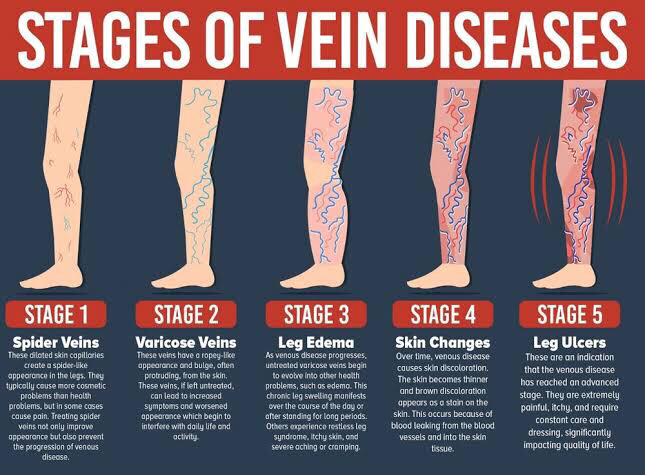
Deep Vein Thrombosis (DVT) is the medical term for clots that form deep in the tissues and can pose serious health risks.

- Medicinal side effects
Swollen ankles can be a side effect of hormones (like estrogens and testosterone), medicines for blood pressure, depression, anxiety, diabetes, and inflammation, and some steroids.
- Obesity, high-salt diet, alcoholism, and smoking
Your lifestyle has a huge role in determining your health and physical wellness.
Indulging in a salt-rich diet, being overweight, smoking habits, and addiction can all cause swollen ankles indirectly and sometimes directly. Matters worsen when one lacks exercise and has poor water intake.
- Heart, liver, and kidney diseases
Diseases of the heart, liver, and kidneys can be probable causes of your swollen ankles. If the heart is not pumping the blood properly to the limbs, you can face edema.
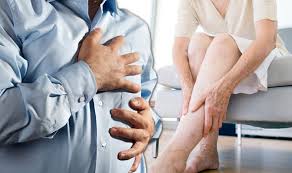
Meanwhile, a liver that does not produce sufficient albumin, which keeps the blood from leaving the walls of veins, can also result in edema.
Similarly, if one’s kidneys do not remove excess fluids from the blood and are not functioning well, you can also experience swollen feet.
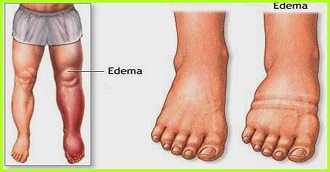
Interestingly, sometimes the exact cause is unknown and has no clear medical explanation. Such a condition is known as idiopathic edema.
Are swollen ankles dangerous to your health?
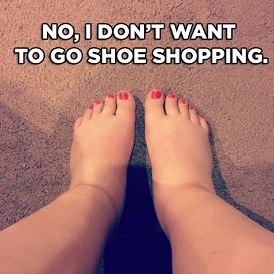
Swollen ankles and feet may cause discomfort, heaviness, and soreness. Still, they do necessarily signal a life-threatening situation. However, since these may have some other underlying cardiovascular, liver, and kidney disease, it is best to visit your doctor to get professional medical advice and follow what he or she says.
Some of the complications that can be potentially dangerous to your health include an increase in swelling area and magnitude, irritation, redness of the skin, chest pain, breathlessness, and nausea. Moreover, skin ulcers can form and become lethal if germs and bacteria infect them. In these instances, it is best to visit a healthcare facility.
How to get rid of swollen ankles

There can be several causes or even some underlying diseases to your problem, and unless properly diagnosed and treated, your condition will not improve. Light or very mild swelling can go away on its own, without any treatment or medication. You can use the following simple remedies, however, to control and treat swollen ankles.
- Massage the affected area

Massaging your limbs can relieve your swollen ankles to a certain degree. However, if the swelling is severe, this may not be a good idea, as it may cause more pain and augment inflammation.
- Elevation technique

Elevating your legs can draw the fluids and blood away from your feet and ankles back towards the core of the body.
You don’t need to be an expert for this remedy to work. Simply place pillows beneath your feet or lie on an inclined surface to elevate them. Then, let gravity do its work. The elevation technique is a quick temporary fix for your condition.
- Oral medications
Diuretic drugs like furosemide can also help remove excess body fluids through urine. Self-medication, however, can be very dangerous, so make sure to follow what your doctor says.
It may be a better option to choose socks for swollen feet.
- Exercise

Physical activity and exercise can promote blood flow towards your limbs and improve overall blood circulation. Regular exercise is also beneficial for your overall health and general well-being.
- Improving your diet
A healthy diet and drinking adequate amounts of water, or generally keeping a more healthy lifestyle, can help fight the causes of swollen ankles and feet.
- Compression therapy
Compression therapy is clinically proven to mitigate swollen ankles and feet significantly.

It is one of the most accessible remedies for edema, whatever the cause may be, and may help control venous insufficiencies and varicose veins. It is also great during post-surgical rehabilitation and during pregnancy.
Compression socks for the treatment of ankle swelling
Unfortunately for some individuals, swollen ankles and feet can be chronic and may last forever. Nurses, medical staff, people who perform shift duties, and others whose careers require prolonged sitting or standing are especially prone to them.
Compression therapy presents a simple and easy way to reduce this swelling with minimal side-effects.
You can wear compression stockings or sleeves under your clothes while at work or home.
Compression therapy using bandages, hoses, sleeves, socks, and tubes was first used for post-surgical recovery patients and pregnant women.
The popularity of compression garments has increased significantly recently. It is now popular among athletes, elders, nurses, and other ordinary individuals. These garments also help reduce the risk of sports injuries, prevent fluid build-up, and reduce the chances of clotting and other severe medical conditions.
How do these garments reduce swollen feet and ankles?
Compression garments apply pressure continuously on the wearer’s leg, foot, and ankle region. This gentle squeezing develops into a gradient of pressure that pushes the blood inside the blood vessels and forces it to leave the extremities.
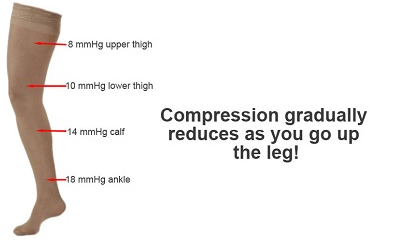
With this simple mechanical principle, compression stockings can successfully keep the blood from pooling in the ankles and feet. The regular use of compression socks can combat swelling of ankles, legs, and thighs.
Tips on how to choose your compression socks
These garments are usually available in a variety of designs, sizes, lengths, and compression levels.
To make the compression therapy a success, pick the correct size, length, and compression level for your socks. Each of the compression levels (light, mild, moderate, and high) of the socks is suitable for a different set of symptoms and conditions.
A moderate compression level (20 mm Hg to 30 mm Hg) is usually ideal for mitigating the problem, while higher levels usually need a doctor’s medical advice.
Your garment’s length can vary according to personal preference and individual symptoms and can reach the knee, thigh, or waist. The garments also come in different types: regular, open-toe, or in the form of compression sleeves (with no feet part).
How to use compression stockings when you suffering from swollen ankles and feet
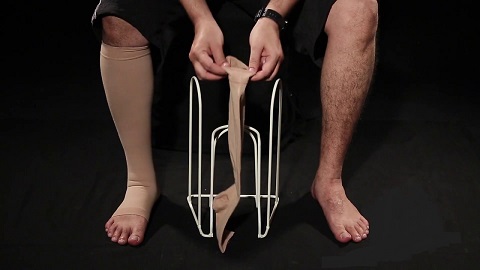
Compression socks are usually safe to wear throughout the, and unless medically recommended, you should take them off before going to bed.
Make sure to pick the right one for you, too. If the compression level is not correct, you might not get the desired results you need. If it is too high, your garment can cut off blood circulation, but it’s is too low, you may not be able to prevent the swelling. The garment has to be snug but not constricting.
Avoid using ointments and skincare products before wearing your compression garments.
Some “do’s and don’ts” on using compression socks when you’re suffering from swollen ankles
The do’s

- Give yourself a break and try elevating your lower body and relax
- Adopting a healthy workout routine plus regularly exercising increases blood circulation through the lower body
- Choose comfortable and soft footwear, preferably low heel
- Choose footwear and hosiery that is snug but not too tight
- Pamper yourself and give your feet and ankles the care they deserve regularly
- Improve your hygiene and keep your feet clean and dry to reduce any risk of infection
- If the swelling is persistent, book an appointment with your doctor and listen to what he or she says
- If the swelling happens only in one ankle only (unilateral), this can be due to trauma, and you must consider visiting the emergency room
- If there is a sudden change in heart rate and blood pressure, or you have chest pain along with swollen ankles, you must immediately rush to the hospital or call an ambulance
The don’ts

- Do not keep the same posture or remain immobile for long durations
- Do not wear garments, footwear, and compression socks that are too constricting
- Do not take any infection, progressing disease, or increased swelling lightly, and see your physician as soon as possible.
Compression socks are both effective and inexpensive

Edema and ankle swelling can be painful, but these can be addressed simply by putting on your compression hosiery whenever you’re outside, or even inside, the house. When combined with other measures and adopting the necessary precautions, you increase your chances of living a healthy, pain-free life.
